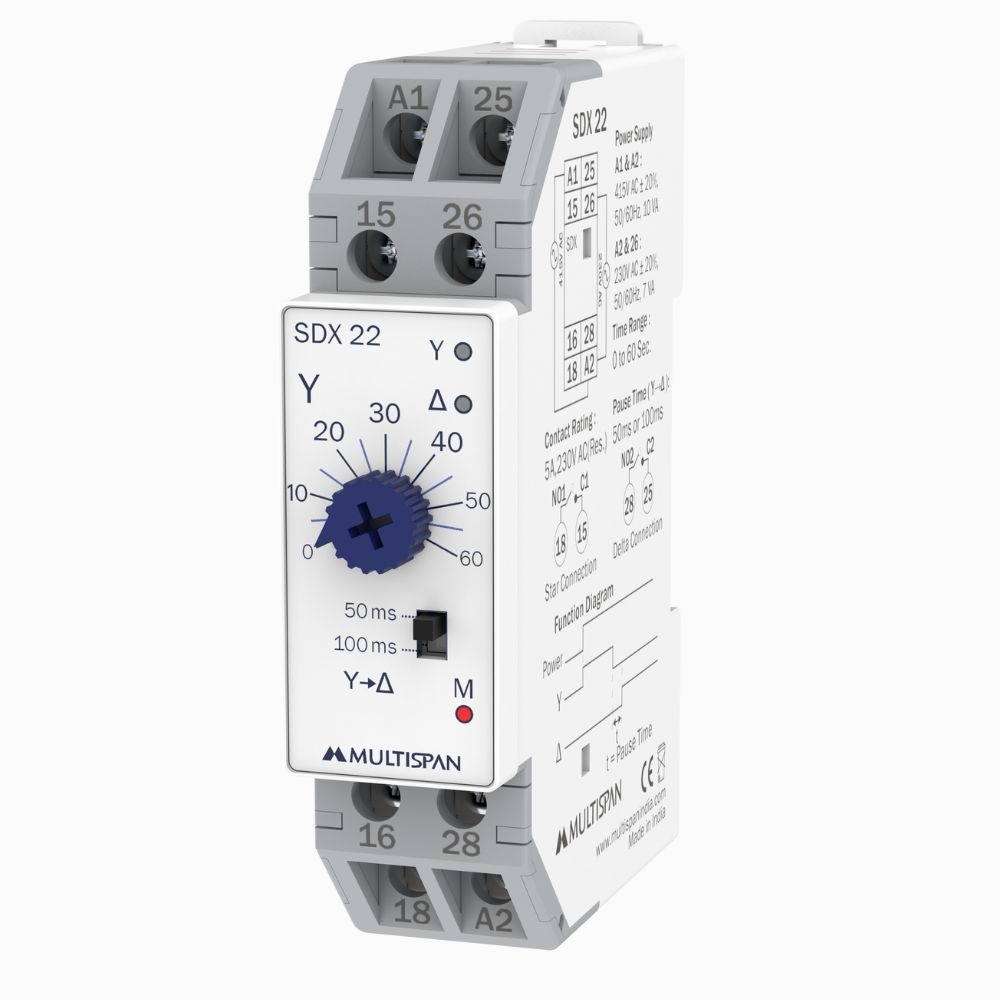A star-delta timer is a device used in an electrical control system to manage the starting sequence of a three-phase induction motor. It works by controlling two contactors: a star contactor and a delta contactor. The timer ensures the motor starts in a star configuration and then switches to a delta configuration after a predetermined time. Why It's Used This starting method, known as star-delta starting, is used to reduce the high inrush current that occurs when a motor starts. The inrush current can be up to 6-8 times the motor's full-load current. By starting in a star configuration, the voltage across each motor winding is reduced to 1/ 3 of the line voltage, which in turn reduces the starting current to 1/3 of the full-load current. Once the motor has accelerated to a sufficient speed, the timer switches the connection to delta, allowing the motor to receive the full line voltage and operate at its normal power and speed. How It Works The timer has a time delay function, typically adjustable, that determines how long the motor runs in the star configuration. Initial State: When the 'start' button is pressed, the main contactor and the star contactor are energized. The motor is connected in a star configuration (Y), where one end of each winding is connected to a common point, and the other ends are connected to the three phases of the power supply. The star-delta timer begins its count. Transition: After the preset time delay expires, the timer signals for a change. It first de-energizes the star contactor, creating a brief open-circuit delay (typically around 50 milliseconds) to prevent a short circuit. This delay is known as the transition time or dead time. Final State: After the dead time, the timer energizes the delta contactor. The motor windings are now connected in a delta configuration (Δ), where they are connected end-to-end, and the three-phase power supply is connected to the junctions. The motor operates normally in this configuration. A Star Delta Timer is a type of timer used in star-delta motor starters, which are commonly employed to start large induction motors with reduced starting current. 🔧 What is a Star Delta Starter? A Star-Delta Starter is a type of reduced voltage starter that initially connects the motor windings in a star (Y) configuration to reduce the voltage applied to each winding. After a preset time delay, it switches to a delta (Δ) configuration for normal operation. ⏲️ Purpose of the Star Delta Timer The timer in a star-delta starter is critical because it controls how long the motor runs in the star connection before switching to delta. The sequence: Start button pressed → Motor starts in star mode (low voltage). Timer starts. After the preset time (e.g., 5–15 seconds), the timer switches the motor to delta mode (full voltage). Motor now runs in full power. 🧠 How It Works (Simplified Diagram): START → STAR CONTACTOR ON → TIMER RUNNING ↓ after time STAR OFF → DELTA CONTACTOR ON ⚙️ Key Timer Parameters Delay time: Usually adjustable between 1–30 seconds. Mode: Star to Delta switch over. Control voltage: Commonly 24V, 110V, 220V AC/DC depending on system. Contact rating: Depends on the motor size and control circuit. 📦 Types of Star Delta Timers Analog timers: Simple dial-based timers. Digital timers: More precise, often with digital displays. Programmable timers: Advanced options for customized delay and control. 🔌 Wiring Overview In a typical star-delta starter: The timer is wired into the control circuit. It controls two contactors: One for star mode One for delta mode 🛑 Why Timing is Important If the delay is too short, the motor may not reach enough speed before switching — causing high current draw. If the delay is too long, the motor runs unnecessarily long in star mode — causing low torque. 🛠 Example Timer Setting Motor HP Suggested Delay Time 10 HP 5–7 seconds 50 HP 10–15 seconds 100 HP 15–20 seconds Would you like: A circuit diagram of a star-delta timer? A list of recommended timer modules? Help with wiring or PLC programming for star-delta control? 0 Second to 60 Seconds Pause time selection 50mSec and 100mSec Aux Supply 415VAC or 230V AC Selectable Size: (H)90mm x (W)22.5mm x (D)72mm
Chat with us on WhatsApp
×
This is your website preview.
Currently it only shows your basic business info. Start adding relevant business details such as description, images and products or services to gain your customers attention by using Boost 360 android app / iOS App / web portal.
https://www.sparkelectric.co.in/latest-update/star-delta-timer-supplier-and-distributor-in-noida/50
Star Delta Timer supplier and distributor in noida..................................................

2025-09-16T06:00:41
A star-delta timer is a device used in an electrical control system to manage the starting sequence of a three-phase induction motor. It works by controlling two contactors: a star contactor and a delta contactor. The timer ensures the motor starts in a star configuration and then switches to a delta configuration after a predetermined time. Why It's Used This starting method, known as star-delta starting, is used to reduce the high inrush current that occurs when a motor starts. The inrush current can be up to 6-8 times the motor's full-load current. By starting in a star configuration, the voltage across each motor winding is reduced to 1/ 3 of the line voltage, which in turn reduces the starting current to 1/3 of the full-load current. Once the motor has accelerated to a sufficient speed, the timer switches the connection to delta, allowing the motor to receive the full line voltage and operate at its normal power and speed. How It Works The timer has a time delay function, typically adjustable, that determines how long the motor runs in the star configuration. Initial State: When the 'start' button is pressed, the main contactor and the star contactor are energized. The motor is connected in a star configuration (Y), where one end of each winding is connected to a common point, and the other ends are connected to the three phases of the power supply. The star-delta timer begins its count. Transition: After the preset time delay expires, the timer signals for a change. It first de-energizes the star contactor, creating a brief open-circuit delay (typically around 50 milliseconds) to prevent a short circuit. This delay is known as the transition time or dead time. Final State: After the dead time, the timer energizes the delta contactor. The motor windings are now connected in a delta configuration (Δ), where they are connected end-to-end, and the three-phase power supply is connected to the junctions. The motor operates normally in this configuration. A Star Delta Timer is a type of timer used in star-delta motor starters, which are commonly employed to start large induction motors with reduced starting current. 🔧 What is a Star Delta Starter? A Star-Delta Starter is a type of reduced voltage starter that initially connects the motor windings in a star (Y) configuration to reduce the voltage applied to each winding. After a preset time delay, it switches to a delta (Δ) configuration for normal operation. ⏲️ Purpose of the Star Delta Timer The timer in a star-delta starter is critical because it controls how long the motor runs in the star connection before switching to delta. The sequence: Start button pressed → Motor starts in star mode (low voltage). Timer starts. After the preset time (e.g., 5–15 seconds), the timer switches the motor to delta mode (full voltage). Motor now runs in full power. 🧠 How It Works (Simplified Diagram): START → STAR CONTACTOR ON → TIMER RUNNING ↓ after time STAR OFF → DELTA CONTACTOR ON ⚙️ Key Timer Parameters Delay time: Usually adjustable between 1–30 seconds. Mode: Star to Delta switch over. Control voltage: Commonly 24V, 110V, 220V AC/DC depending on system. Contact rating: Depends on the motor size and control circuit. 📦 Types of Star Delta Timers Analog timers: Simple dial-based timers. Digital timers: More precise, often with digital displays. Programmable timers: Advanced options for customized delay and control. 🔌 Wiring Overview In a typical star-delta starter: The timer is wired into the control circuit. It controls two contactors: One for star mode One for delta mode 🛑 Why Timing is Important If the delay is too short, the motor may not reach enough speed before switching — causing high current draw. If the delay is too long, the motor runs unnecessarily long in star mode — causing low torque. 🛠 Example Timer Setting Motor HP Suggested Delay Time 10 HP 5–7 seconds 50 HP 10–15 seconds 100 HP 15–20 seconds Would you like: A circuit diagram of a star-delta timer? A list of recommended timer modules? Help with wiring or PLC programming for star-delta control? 0 Second to 60 Seconds Pause time selection 50mSec and 100mSec Aux Supply 415VAC or 230V AC Selectable Size: (H)90mm x (W)22.5mm x (D)72mm
2025-09-16T06:00:41

Submit Your Enquiry